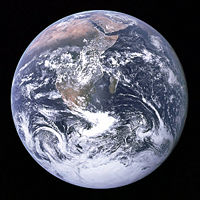Earth (planet): Difference between revisions
imported>Joshua Hughes mNo edit summary |
imported>John Stephenson (Some copyedit; link correction) |
||
| Line 6: | Line 6: | ||
Look closer, however, and Earth becomes more interesting. An observer who could survive the heavy [[pollution]] in the [[atmosphere]] would discover that Earth is home to millions of [[species]], with the [[human]] being the dominant species. These creatures have survived through ruthlessly exploiting Earth's resources, [[global warming|warming the Earth]] as they do so. In all likelihood, Earth will survive the human species, as its fragile [[ecosystem]] turns against them - [[flooding]], [[drought]] and extreme [[weather]] seem to be more common today than in planet's recent past. | Look closer, however, and Earth becomes more interesting. An observer who could survive the heavy [[pollution]] in the [[atmosphere]] would discover that Earth is home to millions of [[species]], with the [[human]] being the dominant species. These creatures have survived through ruthlessly exploiting Earth's resources, [[global warming|warming the Earth]] as they do so. In all likelihood, Earth will survive the human species, as its fragile [[ecosystem]] turns against them - [[flooding]], [[drought]] and extreme [[weather]] seem to be more common today than in planet's recent past. | ||
The accepted [[science|scientific]] view is that Earth and every other object in the [[solar system]] descend from a great cloud of interstellar [[gas]] and dust that condensed to form the sun about 4.6 billion [[year]]s ago. Life is known to have found a foothold only on Earth - more than 3.5 billions years ago - however, in recent years, researchers have made advances concerning potential habitats for life on other planets or their [[natural satellite|moon]]s. | |||
==Footnotes== | ==Footnotes== | ||
Revision as of 23:48, 15 February 2008

Earth is the only place in the universe known to harbour life. It is the third planet out from its sun. Earth orbits around 93 million miles from the sun, within a region neither too hot nor too cold for its inhabitants to exist. In appearance, it is a blue-and-white little world, settled in a backwater region of the Milky Way galaxy. Its inhabitants have been described as "mostly harmless".[1]
Look closer, however, and Earth becomes more interesting. An observer who could survive the heavy pollution in the atmosphere would discover that Earth is home to millions of species, with the human being the dominant species. These creatures have survived through ruthlessly exploiting Earth's resources, warming the Earth as they do so. In all likelihood, Earth will survive the human species, as its fragile ecosystem turns against them - flooding, drought and extreme weather seem to be more common today than in planet's recent past.
The accepted scientific view is that Earth and every other object in the solar system descend from a great cloud of interstellar gas and dust that condensed to form the sun about 4.6 billion years ago. Life is known to have found a foothold only on Earth - more than 3.5 billions years ago - however, in recent years, researchers have made advances concerning potential habitats for life on other planets or their moons.
Footnotes
- ↑ Adams (1979).
References
Adams, D. (1979) The Hitchiker's Guide to the Galaxy. London: Macmillan. ISBN 0330258648.